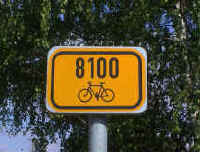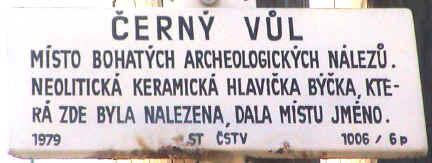 Click
here
for Horse Riding
Click
here
for Horse Riding|
[ Home
] [
Cottages
] [
Photos
] [
Guest Comments ] [
Travel ] [
City Tips ] [
Exploring the Countryside ]
[ Local Pubs
] [
Wheelchairs
] [Weddings]
[
Currency Converter
] [ Book Now!
] [
Contact Us
]
|
 Click
here
for Horse Riding
Click
here
for Horse Riding Conifer
Cottage is not on a road, but is on "cycle track 8100".
Conifer
Cottage is not on a road, but is on "cycle track 8100".
(But do not worry, cars and
taxis can drive up to the house!)
By request, we will be
pleased to provide you with bicycles.
Following a stream flowing down into the Vltava river, cycle
track 8100 runs
through a delightful forested National Park
called "Tyche Udoli" which
means "Silent Valley". Inclines are
gentle and the track has a
reasonable surface, making cycling
and rambling and running
easy and pleasurable. Click
here for photos.
 Idyllic
Prague would be happy to arrange local
Idyllic
Prague would be happy to arrange local
horse riding for Guests from a local stable with
whom IdyllicPrague have a close relationship.
The cost is a very reasonable 400kc per hour
payable directly to the stables. {Note, IdyllicPrague
is happy to make the arrangements and to confirm
the good reputation of the service. However
IdyllicPrague will not be a party to the transaction and
cannot guarantee the quality or safety of the service.}
 IdyllicPrague
Conifer Cottage fronts onto cycle track 8100
IdyllicPrague
Conifer Cottage fronts onto cycle track 8100
which runs West to Okoř castle, and runs East through "Tiché údolí"
(Silent Valley National Park) to the
rope ferry. These forest
lake-side tracks are perfect for gently exploring the countryside
and wildlife. (There are also much more strenuous routes for the
athletic and adventurous.) IdyllicPrague Guests have greatly
enjoyed exploring the area on bicycles. For
more information click
here.
For a blog written by an enthusiastic
local cyclist, click
here.
http://www.praguebikeblog.blogspot.com/
 Idyllic
Prague would be happy to arrange for
Idyllic
Prague would be happy to arrange for
a horse drawn carriage to collect you from your
IdyllicPrague.com Cottage and take you for a
tour of the local countryside. The cost is a very
reasonable 1,000kc (Ł35) per hour (800kc (Ł27
out of season) payable directly to the driver.
{Note, IdyllicPrague is happy to make the
arrangements and to confirm the good reputation of
the service. However IdyllicPrague will not be a party
to the transaction and cannot guarantee the quality
or safety of the service.}
Click here for Swimming in Local Lakes

Click here for Swimming in Local Lakes
 Cerny Vul translates as "Black
Bullock".
Cerny Vul translates as "Black
Bullock".
A sign on the cycle
path
states "Cerny Vul is a site of rich
archaeological finds. A
Neolithic
ceramic bull's head
found here gave
the village its name."
This area is famous for the
Únětice culture which is
the name given
to an early
Bronze Age
culture
 Conifer
Cottage is not on a road, but is on "cycle track 8100".
Conifer
Cottage is not on a road, but is on "cycle track 8100".
(But do not worry, cars and
taxis can drive up to the house!)
The cycle track makes an excellent route for bicycles, horses,
ramblers or a horse drawn carriage.
Following a stream flowing down into the Vltava river, cycle
track 8100 runs
through a delightful forested National Park
called "Tyche Udoli" which
means "Silent Valley". Inclines are
gentle and the track has a reasonable surface, making the trip
easy and pleasurable. Click
here for photos.
 |
 |
 |
 |
 |
 |
The cycle tracks, paths, forests and lakes of the National Park are as
popular with
ramblers as with cyclists. The tranquil valley and
enticing paths lead to intriguing
wild life discoveries. Click here for photos
When eventually the stream you have been following
meets the main river, turn
left and follow the main river downstream. (Cycle Track 8100 takes a detour
around
the streets, but we recommend that you stay with the path by the stream,
it is a more pleasant.) After about
a mile, you will reach the "rope ferry"
across the main river. It is great fun
to cross
the river on the "rope ferry" - and
Cycle Track 8100 continues for miles the
other
side. Alternatively, having crossed
the river you can turn right
and continue up
river until eventually you will arrive
at Prague Zoo. That is a long cycle ride,
so
it would be
an extremely long walk!
 Another alternative is not to cross the river, but to carry
Another alternative is not to cross the river, but to carry
on on the same
side of
the main river, following the
river down stream. After about a mile the railway
is
on
your left, and a steep hill rises on your left. At the top
of that hill is an extremely
ancient Church, still in use,
claimed to be "the first Church in Bohemia" and situated
in the fascinating village of "Levý Hradec". Click
on the following
links for more pictures and information
1,
2,
3,
4,
5,
6.
Do have a look at the IdyllicPrague photos to get some
idea of where
you can explore. We love it!
See http://www.prazskestezky.cz/unet/index.html
See http://envis.praha-mesto.cz/rocenky/chruzemi/cr2_antx/chu63.htm
The valley of the Únětický potok brook and adjacent slopes and plateaux in the respective cadastres. Cadasters: Roztoky nr. Prague (district Prague-West), Suchdol and Prague 6. Area: 114.2343 ha. Elevation: 195 - 300 m above sea level. Established by the Ordinance of the Ministry of Education No. IX-357-2-51 of August 10, 1951, the Ordinance of the Ministry of Education No. 100.988/51 of September 9, 1951, and the Ordinance of the Ministry of Culture of the Czech Republic No. 14 200/88 of November 29, 1988.
Protection of the general character of the landscape, indigenous flora, minor fauna and geological formations.
The bedrock consists of Proterozoic rocks with the prevalence of greywackes, siltstones and shales and a powerful strip of lydites (silicites in the west. There are also veins of porphyric and basalt rocks. Loamy and stony screes, deluvium, loess with rankers and brown earths on top, relics of tropic weathering. Dispersed boulders below lyditeridges.
Large woods with alternating cow-wheat oak and hornbeam, woodrush oak, heather oak and hornbeam and maple woods. The formerly mown valley meadows change spontaneously into alder woods. The northern bare slopes used to be covered with large heaths which receded after forestation. Similarly the acidophilous rocky steppes and sandy areas on southern slopes are becoming overgrown with shrubs - hawthorn, dog rose, blackthorn and in succession sequence with ash and oak trees. The number of important species includes Corydalis pumila in oak and hornbeam wood, Alyssum montanum on the prophyrite vein, Biscutella varia on the diabase vein, and Corynephorus canescens and Helichrysum arenarium on sandy terraces.
The wood is partly natural and continuous (testified to by the presence of Acalles comutatus), partly artificial, including alien wood species (false acacia, red oak, and others). This is reflected also in invertebrate fauna: typical and significant species can be found in natural parts of the forest only. The number of ground beetles includes e.g. Amara nitida, Poecilus virens, Pterostichus burmeisteri and Abax ovalis, the number of phytophagous leaf beetles e.g. Clytra quadripunctata, Cryptocephalus marginatus, Phylotreta ochripes and Aphtona cyanella, the snout beetles the terricolous Brachysomus echinatus, Trachodes hispidus. The oaks host Polydrusus marginatus and Curculio pellitus, the hazel Curculio nucum, the elm Magdalis armigera, the scots pine Polydrusus impar and others. Plectophloeus erichsoni erichsoni from the Pselaphidae family was found here. The butterfly species include e.g. the swallow-tail (Papilio machaon) and the scarce swallowtail (Iphiclides podalirius), the small tortoiseshell (Aglais urticae) and the garden tiger (Arctia caja). The gastropods are represented by Perforatella bidentata. Numerous vertebrate specis, especially birds. Nesting site of the green and the grey woodpeckers and the wryneck. There are about 50 species of passerines including the icterine warbler, the serin, the bullfinch, the goldfinch and the yellow-hammer. Some 20 mammal species. However, the suslik and the hamster have disappeared.
The better part of the area (over 100 ha) is covered with mixed woods at present with the prevalence of oaks (42.5%), pines (21.4%), hornbeams (10.9%) and birches (7.7%). The admixture of the red oak propagates intensively by shoots. Inadequate wood species planted after the Second World War devastated completely some valuable areas, such as the area covered with Filipendula ulmaria below the Kozí hřbety ridge.
The forest was influenced anthropically as early as in the prehistorc time. There is a Hallstatt mound burial ground on the plateau. The slopes were used as pastures and subjected to secondary forestation only at the beginning of the 20th century. The area is threatened by heavy tourist traffic (from the nearby city). Forest management conforms with the approved forest management plan. Accidental tree felling, hunting, grazing. There is an educational track through the reserve.
Kubíková (1985), Kubíková, Molíková (1980).
[ Home
] [
Cottages
] [
Photos
] [
Guest Comments ] [
Travel ] [
City Tips ] [
Exploring the Countryside ]
[ Local Pubs
] [
Wheelchairs
] [Weddings]
[
Currency Converter
] [ Book Now!
] [
Contact Us
]